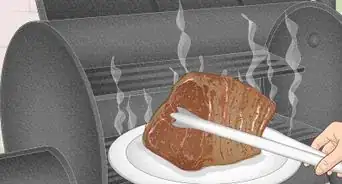This article was co-authored by wikiHow Staff. Our trained team of editors and researchers validate articles for accuracy and comprehensiveness. wikiHow's Content Management Team carefully monitors the work from our editorial staff to ensure that each article is backed by trusted research and meets our high quality standards.
This article has been viewed 50,463 times.
Learn more...
Propane is a high-energy alternative to traditional fossil fuels that is known for its low emissions due to minimal carbon levels. It can be used to power everything from portable stoves and barbeques to home heating appliances and backup electric generators. Regardless of what you're using it for, you'll either be renting a tank or purchasing one, and knowing how to determine the right path will give you the best fuel for your money.
Steps
Selecting a Tank Size
-
1Determine what your propane tank is for. Whether you purchase a propane tank or lease one, the best way to start narrowing down your choices is by asking yourself what you need propane for. It can be used for drying clothes, heating your home, and cooking, among other things.
- Make a list of all the things you do that are going to use propane for and then determine the range of propane usage you need.[1]
-
2Choose a 4.7 gallon (18 L) tank for barbeque grills. If you're barbecuing, the smaller portable tanks that you can purchase or exchange at local hardware, big-box, and grocery stores are best. Anything more and you should consider a bigger tank.
- Gas stations also typically supply small propane tanks.
Advertisement -
3Select a 500 gallon (1,900 L) or 1,500 gallon (5,700 L) tank for families. The average family that uses propane to heat their home uses around 1,200 gallons (4,500 L) each year. This means a 500 gallon (1,900 L) tank will need to be refilled about 3 times a year, and a 1,500 gallon (5,700 L) tank about 1 time per year.
- Families that also want to use propane appliances such as dryers, hot water heaters, and stoves use around 1,500 gallons (5,700 L) each year, so similar tank sizes are suitable.
-
4Determine your tank size based on location and propane needs. Most residential tanks located above ground are 120 gallons (450 L), 250 gallons (950 L), 500 gallons (1,900 L), or 1,000 gallons (3,800 L). Underground tanks are typically either 500 gallons (1,900 L) or 1,000 gallons (3,800 L). Always compare the amount of space you have in your yard with the available tank sizes so you know you have enough space to accommodate your propane.[2]
- 250 gallons (950 L) tanks are 7.5 inches (19 cm) in length and 30 inches (76 cm) in diameter; 320 gallon (1,200 L) tanks are 10 inches (25 cm) in length and 30 inches (76 cm) in diameter; 500 gallon (1,900 L) tanks are 10 inches (25 cm) long and 37 inches (94 cm) in diameter; and 1,000 gallon (3,800 L) gallon tanks are 16 inches (41 cm) long and 41 inches (100 cm) in diameter.
-
5Choose a price range that suits your budget. Propane tanks can run anywhere from $500 to over $2000. That's a pretty big price range, so decide on your limit and look for tanks that are going to offer you the size you need and nothing more to avoid spending too much money.[3]
- 1,000 gallon (3,800 L) tanks are the most expensive and are around $2,699 new and $1,899 used.
- 500 gallon (1,900 L) tanks are around $1,699 new and $799 used.
- Anything less than $1,000 is going to be 500 gallons (1,900 L) or less. For example, 500 gallon (1,900 L) tanks are $799 used, 320 gallon (1,200 L) tanks are $699 used, 250 gallon (950 L) tanks are $599 used, and 120 gallon (450 L) vertical tanks are around $549 used.
Obtaining and Placing Your Tank
-
1Start scouting for potential locations for your tank. Propane tanks need to be close to all-weather roads so that the delivery truck hoses—typically between 100 to 150 feet (30 to 46 m)—can reach them in bad weather. Professional installation is recommended, although if you have the motivation you can dig your own hole.[4]
- For a 500 gallon (1,900 L) tank, the typical hole size is around 5 feet (1.5 m) in depth and width with a length of around 12 feet (3.7 m).
- If you invest in professional installation, be sure to take notes and pictures of the installation and keep them recorded. This information comes in handy when switching tanks or providers.
- Most regions have certain requirements that determine how and where propane installation can take place. You'll probably have to visit a local fire department for permits. Some regions require an additional plumbing permit, which you can get from local planning departments. All permits are around $25 to $50 and typically don't have to be renewed.
-
2Purchase a used propane tank on classified sites for the lowest price. You can find used 500 gallon (1,900 L) propane tanks on sites like Craigslist for between $375 to $625, which equates to around $0.75 to $1.5 per 1 gallon (3.8 L). These prices can vary depending on your area. Contact propane dealers and ask them about the requirements and costs for certifying and testing used tanks.[5]
- Never purchase a tank with a missing or unreadable manufacturer's plate. Always make sure it has the "U" ASME stamp, and ask if cylinders are in good condition and up to date.[6]
- Some of the popular manufacturers that you can buy tanks from are Trinity Industries and American Welding and Tank. National dealers like Ferrellgas, Suburban Propane, and AmeriGas both sell and lease tanks.
- Contact the National Propane Gas Association for propane retailer referrals in your area by providing them with your zip code.
-
3Buy a propane tank new from a manufacturer for higher quality. Contact the National Propane Gas Association and give them your zip code for referrals to propane retailers in your area. Shop and compare all of the prices from different suppliers—you don't get this kind of freedom when leasing, so take advantage of it.[7]
- Choose your preferred color, or even paint the tank yourself.
- Keep in mind that liability is on you when you own a tank. This includes propane leaks, and any problems that result from undetected repairs.
- Maintain your tank and invest in repairs from local hardware stores or manufacturers. Refer to your appliance service manual for recommended maintenance frequency.
Purchasing Your Propane
-
1Buy, exchange or refill a small propane tank for barbecuing. If you need a smaller propane tank suitable for a barbeque, head to a local hardware, grocery, or big-box store. You can purchase tanks, exchange an existing tank for a new full one, or pay for a refill.[8]
- Exchanges are typically more—20 pound (9.1 kg) tanks hold around 4.7 gallons (18 L) of propane, which means you're paying about $18.47 at a price of $3.93 per gallon.
- Avoid locations that charge by the tank, as you're essentially paying more, since the price is the same even if a bit of propane is left in it. Also make sure the store is filling your tank all the way—some fill tanks to just 15 pounds (6.8 kg) to save money.
- Fewer hardware stores offer refills, and hours are sometimes limited. Call around first and make sure that a trained employee is on site so you don't have to wait or waste time showing up when no one can service you.
-
2Purchase propane from legal suppliers if you're leasing. Always refer back to the contract prior to purchasing propane. Most homeowners are required to purchase propane strictly from the company that owns the tank. This requirement typically last for 3 to 5 years, but check your contract to be sure.[9] Remember: many of these suppliers will tack on extra charges that can add up to about $120 per year, or $1,200 or more over a period of 10 years.
- In most states, it's illegal for propane companies to fill tanks that are leased from other companies. Many states will fine as much as $10,000 to propane dealers that fill tanks belonging to other companies. But if you lie about owning a leased tank, you are legally responsible for paying this fine.
- Leased tanks typically come with the benefit of the company covering all repair and maintenance expenses.
- The end of the contract gives you the chance to switch to another supplier. If choose to go this route, you'll need to have your old tank removed to make room for the installation of a new one.
-
3Call a local propane supplier for propane pricing prior to delivery. Look into the local propane suppliers in your area. These companies offer residential, industrial, and commercial propane services. Methods of payment vary based on suppliers, so always ask about the available options. Try and use a company with fixed prices so that your propane costs will be consistent whenever you purchase it.
- Always ask about minimum monthly purchasing requirements and propane delivery fees. These fees typically vary depending on the volume of propane fuel.
- Gas stations and department stores like Costco are other common places you can purchase propane.
-
4Arrange for propane delivery to your home after deciding on the product. Most companies offer two kinds of delivery: automatic and as needed. Automatic refers to scheduled deliveries that are based on your estimated propane usage to ensure that your tank is always full. As needed deliveries let you monitor your propane usage on your own and call for a delivery when you need one.
- Automatic delivery works best for high-volume users and people who don't have the time to monitor their propane usage on their own.
Warnings
- Keep sparks and flammable materials away from your tank.⧼thumbs_response⧽
- Propane has a strong, unpleasant smell like rotten eggs or skunk. If you smell gas, leave the area immediately and turn off the main gas supply valve if possible.⧼thumbs_response⧽
- Report the leak to your propane retailer. If you can't reach them, call emergency services or the local fire department.⧼thumbs_response⧽
- Do not return to the area until it has been checked by a qualified technician.[10]⧼thumbs_response⧽
References
- ↑ https://www.eia.gov/dnav/pet/hist/LeafHandler.ashx?n=PET&s=W_EPLLPA_PRS_NUS_DPG&f=W
- ↑ http://home.costhelper.com/propane-tank.html
- ↑ http://home.costhelper.com/propane-tank.html
- ↑ http://home.costhelper.com/propane-tank.html
- ↑ http://home.costhelper.com/propane-tank.html
- ↑ https://www.linkedin.com/pulse/guide-buying-used-propane-tank-john-p-nuckols
- ↑ http://www.tankutility.com/pros-cons-owning-propane-tank/
- ↑ http://www.elivermore.com/propane.htm
- ↑ http://home.costhelper.com/propane-tank.html








































































